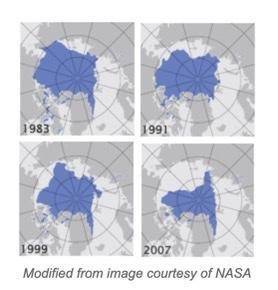
Biology, 01.04.2021 19:50 animationfusion
Arctic ecosystems provide a habitat for many animal species, including polar bears, walruses, Arctic foxes, and seals. The Arctic experienced an overall change in ice coverage between 1983 and 2007. The maps below show the sea ice coverage for each year during this time. In the maps, the blue areas represent locations covered by sea ice, the white areas represent liquid ocean water, and the gray areas represent land masses.
Based on the maps, which of the following is most likely true about the period of time between 1983 and 2007 in this Arctic region?
A. The habitat available to fish in the Arctic area decreased significantly during this time.
B. Most of the ocean habitat in the Arctic became frozen solid during this time.
C. The Arctic region experienced a decrease in the number of types of animals that relied on sea ice.
D. Most Arctic populations that lived on sea ice experienced an increase in size during this time.


Answers: 1


Another question on Biology

Biology, 21.06.2019 22:00
Hey me with this one❤❤❤❤ every organism needs food. does a cell also need it? explain very briefly.
Answers: 2

Biology, 21.06.2019 23:00
Explain how ancient whale fossils found in eqypt are believed to support the theory of evolution.
Answers: 1

Biology, 22.06.2019 01:00
All but one describes an effect of aging on the digestive system. a) decreased acid secretion b) decreased elasticity of stomach c) capacity to resist damage decreases d) food remains in stomach for less time
Answers: 1

Biology, 22.06.2019 05:10
Hydrilla (hydrilla verticillata) is an invasive aquatic plant and one of the most serious aquatic pests in florida. hydrilla has already been introduced to hundreds of bodies of water throughout florida, hydrilla is difficult to control because it grows rapidly and survives in many different water depths and conditions. hydrilla • describe how hydrilla affects native plant and animal species. include both a biotic and an abiotic limiting factor. • suggest one biotic and one abiotic recommendation that could slow the spread of hydrilla
Answers: 3
You know the right answer?
Arctic ecosystems provide a habitat for many animal species, including polar bears, walruses, Arctic...
Questions


Mathematics, 30.11.2020 18:20

Mathematics, 30.11.2020 18:20

Social Studies, 30.11.2020 18:20



History, 30.11.2020 18:20

History, 30.11.2020 18:20


Mathematics, 30.11.2020 18:20



History, 30.11.2020 18:20

Geography, 30.11.2020 18:20

Social Studies, 30.11.2020 18:20

History, 30.11.2020 18:20


Mathematics, 30.11.2020 18:20




